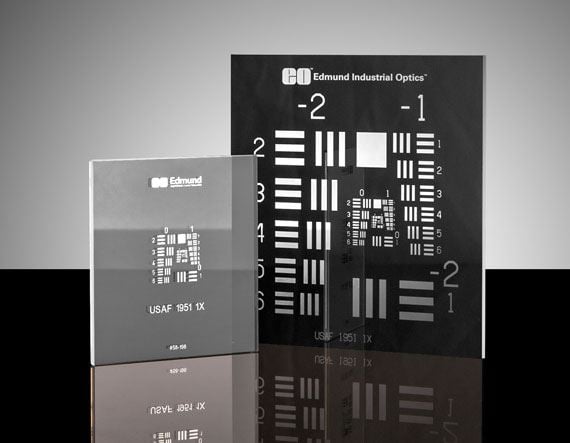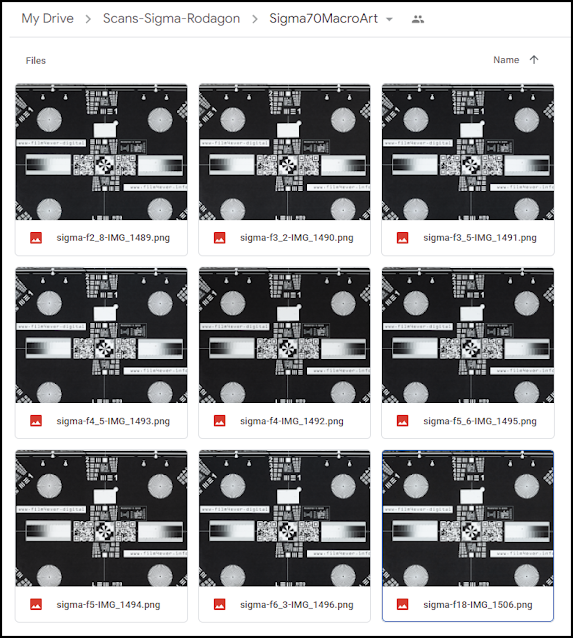How good 35 mm test target actually is?
I have been passed the question from the customer called Mark who provided the following feedback:
The 35mm targets I bought are good value, but aren’t as sharp as I’d hoped for. They are only just good enough to show the limits of my 16MP MFT sensor with 45mm Leica lens, but wouldn’t be good enough to explore the limits of the best full frame cameras and lenses. I’d probably need to buy a chrome on glass target for that, but that would be much more expensive. --Mark
I am actually happy to jump in and argue that my targets are indeed can help folks with the scanning setups of decent resolution.
For starters, let's look how 42 MP (7952x5304) Sony camera resolves the test target.
 |
| Chart 1. Click on the image to see full resolution image open in the new browser tab. |
Now, let's take a closer look at the small chart in the upper right quadrant of the frame.
 |
| Chart 2. Click on the image to see full resolution image open in the new browser tab. |
Before switching to full resolution view of the chart above let's note how USAF 1951 pattern is supposed to be understood. The smallest "element" in the "group" for which a person can distinguish both horizontal and vertical bars is said to correspond to resolving power of the the system - in this case it's digital camera + lens + film target.
 |
| Chart 3. How to read USAF 1951 Resolution Power Chart |
For the Chart #2 above (looking at 100% full resolution), the bars which can be resolved with certainty belong to Group 0 Element 2. Some folks who really want to see more, say they can resolve Group 0 Element 3. To spare you from delving into the math and look-up tables, I marked resolution in line pairs per mm right on the USAF1951 chart. The numbers you see are very specific to this particular chart and this product - 35 mm Vlads Test Target - and will be completely different for any other test target (even my Type 120 target). Basically, we are saying that as long as we can see (resolve) Group 0 Element 2, we are confident that when the same lens and camera will be used to scan real film, the effective resolution will be close to 62 line pairs per mm. Generally speaking, this is a very decent resolution to start with - given that real photo films start showing film grain and color clouds at that same scale. If one wants to count next element Gr 0 El 3 as resolved, that would correspond to 69 lp/mm.
This is all good, but lets see if we are hitting target's limitation as Mark is concerned.
Let's use the much more powerful scanner (courtesy of http://www.high-end-scans.de ). Here is scan which was performed at staggering 24K (24 186 to be exact) pixels per inch - approx. 470 lp/mm ). I cannot post the scan of the whole frame as it is too big - let's just review the area of interest. The corresponding MP count for the complete frame would be 790 MP (sic!). Just to put the things into the perspective: original 42 MP scan of the Resolution fragment vs high-re scan of the same area on film. Below Chart 4 is up to scale pixel count-wise.
 |
| Cart 4. Click on the image to see full resolution image open in the new browser tab. |
Now let see what Vlads Test Target has to offer at that magnification. Let's review the 100% crop by clicking on the image above.
Wow! now you can see the film grain starts to show up. The 35 mm test targets are all produced on Adox CMS 20 II Pro film - the highest resolution film available outside of pure industrial applications like microelectronics. Note, that film is obviously is extremely fine-grained so one needs a lot of optical power to actually observe the grain itself. But let's now review the USAF 1951 patterns. With the proper equipment one can see that Gr 0 El 6 is easily resolved and if one wants even more of bragging rights, the Gr 1 El 1 is about to be resolved. That means that test target itself will not be out-resolved until the scanning system is capable of resolving 98-110 lines per mm. I can guarantee you that in 99% of cases no general purpose black and white or color film combined with conventional camera lenses can present that sort of challenge. The rule of thumb is that the overall resolution of lens + film system is always lower than resolving power of each of them individually. Even if your artistic sense desires film grain to be resolved and play role in the final image, the test target will help you fine tune your scanning setup to achieve that comfortably.
As for the helpfulness of Vlads Test Target in evaluating and comparing different lenses and camera bodies for camera scanning - it will be certainly of the great help - not only because there yet to be a regular/FF digital camera which can out-resolve the targets (even with say pixel-shift), but because of its unique design - which has USAF 1951 patterns strategically placed not only in the center but also close to the frame edges and in the corners. That way the lenses can be easily evaluated not only by resolving power in the center, but also across the frame, the flatness of the field will be apparent from the single shot as well as degree of alignment of the sensor and film plane. See another article Using Vlads Test Targets to Fine-Tune Film Scanning Rig for details.
Certainly there are available industrial-strength targets with USAF 1951 pattern created by vacuum deposited chromium on the glass substrate. See https://www.edmundoptics.com/p/2-x-2-positive-1951-usaf-resolution-target/4306/# Those patterns can achieve astounding resolution all the way up1000 lp/mm, but the price of them is astounding too ;-) . And those targets are actually less useful for the task at hand than my targets. They are made as 2x2 inch square slides which have single USAF1951 pattern placed at the slide center.
 |
| Edmund Optics $180 USAF 1951 2x2 inch target |
Those slides are pretty useless if you want to evaluate such things as image quality consistency between center and corners and to asses lens' flatness of field. The only way to go about those tasks is to move the slides or camera and make multiple shots. Typically, the scanning rigs the majority of folks construct themselves are not capable of the precision required for that exercise to be executed properly. For 95% of folks who do film scanning with the cameras or even with dedicated flatbed scanners like Epson V850 themselves, mere US$30 will go long way once they get themselves Vlads Test Target ;-)
 |
| "Vlads Test Target" on Adox CMS 20 Pro PETA-based film. Available in Europe from Pixl-latr (UK) and Valoi (Finland, EU) stores. |




Comments
Post a Comment